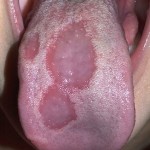
Oral Lichen Planus (OLP) is a common chronic immunological disease the treatment of which remains a challenge for clinicians. Two Cochrane reviews have recently been published regarding the treatment of OLP (Chang et al 2012 and Thongorasom et al 2011 ). The quality of evidence for treatments for OLP is weak, but topical steroids are commonly used as the first line treatment for symptomatic OLP. The aim of this study was to compare the efficacy of low-level laser therapy (LLLT) with CO2 laser surgery in the treatment of OLP.
28 patients (mean age 50.7 years) with and clinical and histological diagnosis of OLP were randomised to receive either LLLT (n=15) or CO2 laser treatment (n=13). Patients were examined at baseline, and after 2 weeks, 1, 2 and 3 months. Main outcomes were reduction in; pain and discomfort (VAS); change in lesion size and clinical response. The commonest sites of lesions were on the buccal mucosa.
- After 3 months, all patients in the LLLT showed either a partial or complete improvement in clinical response compared with only 85% in the CO2 laser group.
- Improvement in pain scores was achieved in both groups. Amelioration in symptomatic response (pain) was significantly higher in the LLLT group in all follow-up stages
The authors concluded
this study showed that LLLT displayed better results than CO2 laser therapy as alternative or additional therapy, but further investigations in comparison with standard treatment modalities with a prolonged follow-up period will be necessary to confirm the efficacy of laser therapy in the treatment of OLP.
Comment
It is important to note that this is a relatively small study and OLP is a chronic condition and this study only reports outcomes at 3 months. It is unclear whether the outcome assessors were blind to treatment allocation. Also the most recent Cochrane review by Chen et al 2011 noted:-
Surgical management, such as carbon dioxide laser, cryotherapy, and excision, is not recommended due to the possibility of triggering lesions (Koebner’s phenomenon) and recurrence of the inflammatory condition.
Links
Agha-Hosseini F, Moslemi E, Mirzaii-Dizgah I. Comparative evaluation of low-level laser and CO(2) laser in treatment of patients with oral lichen planus. Int J Oral Maxillofac Surg. 2012 Jul 9. [Epub ahead of print] PubMed PMID: 22784653.
Cheng S, Kirtschig G, Cooper S, Thornhill M, Leonardi-Bee J, Murphy R. Interventions for erosive lichen planus affecting mucosal sites. Cochrane Database Syst Rev. 2012 Feb 15;2:CD008092. Review. PubMed PMID: 22336835.
Thongprasom K, Carrozzo M, Furness S, Lodi G. Interventions for treating oral lichen planus. Cochrane Database Syst Rev. 2011 Jul 6;(7):CD001168. Review. PubMed PMID: 21735381.
Zakrzewska JM, Chan ES, Thornhill MH. A systematic review of placebo-controlled randomized clinical trials of treatments used in oral lichen planus. Br J Dermatol. 2005 Aug;153(2):336-41. Review. PubMed PMID: 16086745.
American Academy of Oral Medicine OLP page
